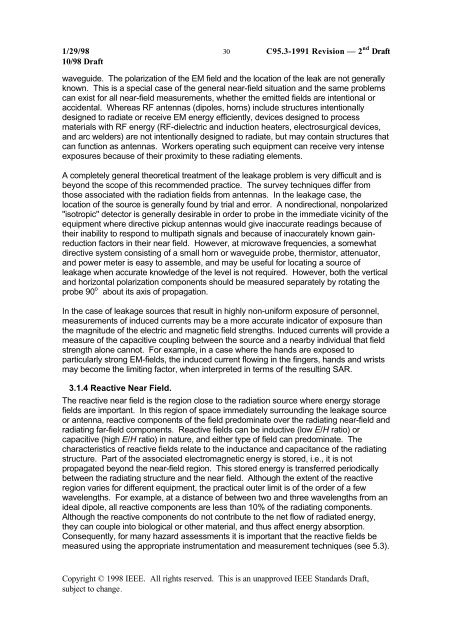DRAFT Recommended Practice for Measurements and ...
DRAFT Recommended Practice for Measurements and ...
DRAFT Recommended Practice for Measurements and ...
Create successful ePaper yourself
Turn your PDF publications into a flip-book with our unique Google optimized e-Paper software.
1/29/98 30 C95.3-1991 Revision — 2 nd Draft<br />
10/98 Draft<br />
waveguide. The polarization of the EM field <strong>and</strong> the location of the leak are not generally<br />
known. This is a special case of the general near-field situation <strong>and</strong> the same problems<br />
can exist <strong>for</strong> all near-field measurements, whether the emitted fields are intentional or<br />
accidental. Whereas RF antennas (dipoles, horns) include structures intentionally<br />
designed to radiate or receive EM energy efficiently, devices designed to process<br />
materials with RF energy (RF-dielectric <strong>and</strong> induction heaters, electrosurgical devices,<br />
<strong>and</strong> arc welders) are not intentionally designed to radiate, but may contain structures that<br />
can function as antennas. Workers operating such equipment can receive very intense<br />
exposures because of their proximity to these radiating elements.<br />
A completely general theoretical treatment of the leakage problem is very difficult <strong>and</strong> is<br />
beyond the scope of this recommended practice. The survey techniques differ from<br />
those associated with the radiation fields from antennas. In the leakage case, the<br />
location of the source is generally found by trial <strong>and</strong> error. A nondirectional, nonpolarized<br />
''isotropic'' detector is generally desirable in order to probe in the immediate vicinity of the<br />
equipment where directive pickup antennas would give inaccurate readings because of<br />
their inability to respond to multipath signals <strong>and</strong> because of inaccurately known gainreduction<br />
factors in their near field. However, at microwave frequencies, a somewhat<br />
directive system consisting of a small horn or waveguide probe, thermistor, attenuator,<br />
<strong>and</strong> power meter is easy to assemble, <strong>and</strong> may be useful <strong>for</strong> locating a source of<br />
leakage when accurate knowledge of the level is not required. However, both the vertical<br />
<strong>and</strong> horizontal polarization components should be measured separately by rotating the<br />
probe 90 o about its axis of propagation.<br />
In the case of leakage sources that result in highly non-uni<strong>for</strong>m exposure of personnel,<br />
measurements of induced currents may be a more accurate indicator of exposure than<br />
the magnitude of the electric <strong>and</strong> magnetic field strengths. Induced currents will provide a<br />
measure of the capacitive coupling between the source <strong>and</strong> a nearby individual that field<br />
strength alone cannot. For example, in a case where the h<strong>and</strong>s are exposed to<br />
particularly strong EM-fields, the induced current flowing in the fingers, h<strong>and</strong>s <strong>and</strong> wrists<br />
may become the limiting factor, when interpreted in terms of the resulting SAR.<br />
3.1.4 Reactive Near Field.<br />
The reactive near field is the region close to the radiation source where energy storage<br />
fields are important. In this region of space immediately surrounding the leakage source<br />
or antenna, reactive components of the field predominate over the radiating near-field <strong>and</strong><br />
radiating far-field components. Reactive fields can be inductive (low E/H ratio) or<br />
capacitive (high E/H ratio) in nature, <strong>and</strong> either type of field can predominate. The<br />
characteristics of reactive fields relate to the inductance <strong>and</strong> capacitance of the radiating<br />
structure. Part of the associated electromagnetic energy is stored, i.e., it is not<br />
propagated beyond the near-field region. This stored energy is transferred periodically<br />
between the radiating structure <strong>and</strong> the near field. Although the extent of the reactive<br />
region varies <strong>for</strong> different equipment, the practical outer limit is of the order of a few<br />
wavelengths. For example, at a distance of between two <strong>and</strong> three wavelengths from an<br />
ideal dipole, all reactive components are less than 10% of the radiating components.<br />
Although the reactive components do not contribute to the net flow of radiated energy,<br />
they can couple into biological or other material, <strong>and</strong> thus affect energy absorption.<br />
Consequently, <strong>for</strong> many hazard assessments it is important that the reactive fields be<br />
measured using the appropriate instrumentation <strong>and</strong> measurement techniques (see 5.3).<br />
Copyright © 1998 IEEE. All rights reserved. This is an unapproved IEEE St<strong>and</strong>ards Draft,<br />
subject to change.
















